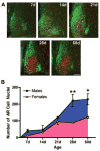Minireview: The neuroendocrinology of the suprachiasmatic nucleus as a conductor of body time in mammals
- PMID: 17901227
- PMCID: PMC3423957
- DOI: 10.1210/en.2007-1083
Minireview: The neuroendocrinology of the suprachiasmatic nucleus as a conductor of body time in mammals
Abstract
Circadian rhythms in physiology and behavior are regulated by a master clock resident in the suprachiasmatic nucleus (SCN) of the hypothalamus, and dysfunctions in the circadian system can lead to serious health effects. This paper reviews the organization of the SCN as the brain clock, how it regulates gonadal hormone secretion, and how androgens modulate aspects of circadian behavior known to be regulated by the SCN. We show that androgen receptors are restricted to a core SCN region that receives photic input as well as afferents from arousal systems in the brain. We suggest that androgens modulate circadian behavior directly via actions on the SCN and that both androgens and estrogens modulate circadian rhythms through an indirect route, by affecting overall activity and arousal levels. Thus, this system has multiple levels of regulation; the SCN regulates circadian rhythms in gonadal hormone secretion, and hormones feed back to influence SCN functions.
Figures




Similar articles
-
Suprachiasmatic nucleus as the site of androgen action on circadian rhythms.Horm Behav. 2015 Jul;73:1-7. doi: 10.1016/j.yhbeh.2015.05.007. Epub 2015 May 24. Horm Behav. 2015. PMID: 26012711 Free PMC article.
-
A role for androgens in regulating circadian behavior and the suprachiasmatic nucleus.Endocrinology. 2007 Nov;148(11):5487-95. doi: 10.1210/en.2007-0775. Epub 2007 Aug 16. Endocrinology. 2007. PMID: 17702841 Free PMC article.
-
Entrainment of circadian clocks in mammals by arousal and food.Essays Biochem. 2011 Jun 30;49(1):119-36. doi: 10.1042/bse0490119. Essays Biochem. 2011. PMID: 21819388
-
Minireview: Entrainment of the suprachiasmatic clockwork in diurnal and nocturnal mammals.Endocrinology. 2007 Dec;148(12):5648-55. doi: 10.1210/en.2007-0804. Epub 2007 Sep 27. Endocrinology. 2007. PMID: 17901231 Review.
-
Circadian actions of melatonin at the suprachiasmatic nucleus.Behav Brain Res. 1996;73(1-2):135-9. doi: 10.1016/0166-4328(96)00085-x. Behav Brain Res. 1996. PMID: 8788491 Review.
Cited by
-
Suprachiasmatic nucleus as the site of androgen action on circadian rhythms.Horm Behav. 2015 Jul;73:1-7. doi: 10.1016/j.yhbeh.2015.05.007. Epub 2015 May 24. Horm Behav. 2015. PMID: 26012711 Free PMC article.
-
Adolescent changes in the homeostatic and circadian regulation of sleep.Dev Neurosci. 2009;31(4):276-84. doi: 10.1159/000216538. Epub 2009 Jun 17. Dev Neurosci. 2009. PMID: 19546564 Free PMC article. Review.
-
Circle(s) of Life: The Circadian Clock from Birth to Death.Biology (Basel). 2023 Feb 28;12(3):383. doi: 10.3390/biology12030383. Biology (Basel). 2023. PMID: 36979075 Free PMC article. Review.
-
The neuroendocrine control of the circadian system: adolescent chronotype.Front Neuroendocrinol. 2012 Aug;33(3):211-29. doi: 10.1016/j.yfrne.2012.04.003. Epub 2012 May 23. Front Neuroendocrinol. 2012. PMID: 22634481 Free PMC article. Review.
-
Remodeling the clock: coactivators and signal transduction in the circadian clockworks.Naturwissenschaften. 2009 Mar;96(3):321-37. doi: 10.1007/s00114-008-0474-9. Epub 2008 Dec 4. Naturwissenschaften. 2009. PMID: 19052721 Review.
References
-
- Klein DC, Moore RY, Reppert SM. Suprachiasmatic nucleus: the mind’s clock. New York: Oxford University Press; 1991.
-
- Weaver DR. The suprachiasmatic nucleus: a 25-year retrospective. J Biol Rhythms. 1998;13:100–112. - PubMed
-
- Gillette MU, Reppert SM. The hypothalamic suprachiasmatic nuclei: circadian patterns of vasopressin secretion and neuronal activity in vitro. Brain Res Bull. 1987;19:135–139. - PubMed

